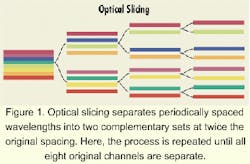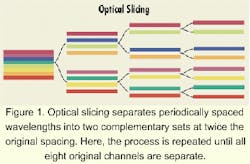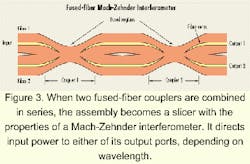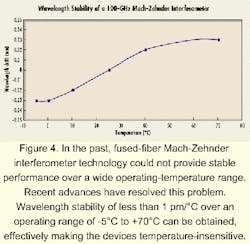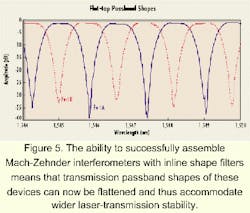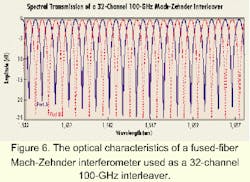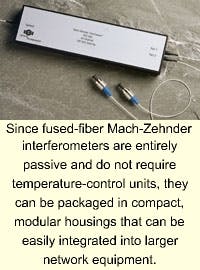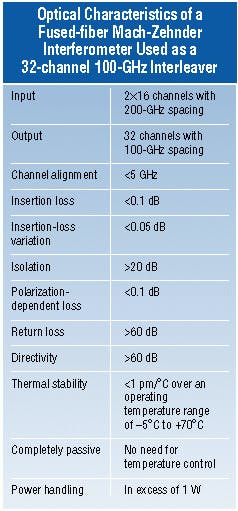Fused-fiber developments offer passive foundation for optical slicing
Stéphane Bourgeois ITF Optical Technologies
Today, dense wavelength-div ision multiplexing (DWDM) is widely recognized as a cost-effective way to provide the multiterabit bandwidth required in large-scale all-optical networks. Until recently, however, the component technologies used in DWDM applications led to system designs based on fixed channel counts. Maximum channel capacity was designed into the network at the start, even if some channels were not used or commissioned immediately-a design approach that resulted in high startup costs.
In 4- or 8-channel systems, this compromise was acceptable. System designers today, however, plan for 16-, 32-, 64-, and even 128-channel systems, and they need design flexibility to manage wavelength use at any point in the network's evolution. With traditional DWDM component technologies such as thin-film filters, arrayed waveguides, or fiber Bragg gratings, designers face the expense of complex high-channel-count, narrow-spaced devices and the performance penalty paid as insertion loss increases with the number of channels. To make matters worse, performance penalties increase when modular products are used to enhance flexibility.
An attractive way to overcome the flexibility, performance, and cost difficulties associated with traditional DWDM networks is with optical slicing and interleaving facilitated by a groundbreaking achievement in component technology. With optical slicing/interleaving, channels can be separated or combined at any point, giving the system designer complete control over routing along the network.
Optical slicing is the separation of a set of periodically spaced wavelengths into two complementary sets at twice the original spacing. The inverse technique, optical interleaving, is combining two appropriately spaced sets of wavelengths into a single equally spaced set.The flexibility of optical slicing/ interleaving resides in the symmetry of the slicing/interleaving operation and in its suitability for series use in a cascaded fashion (see Figure 1). This technique can be employed in many applications, including multiplexing and demultiplexing sets of wavelengths or routing wavelengths at any point in the network architecture.
The greatest benefit of optical slicing is that at each stage of channel separation in the network, downstream complexity is halved. When traditional DWDM component technology is used, channel wavelengths remain narrowly spaced even in the farthest elements of the network. But when optical-splicing technology is applied, wavelength separation doubles at each branch point. Optical slicing/ interleaving enhances network design when it is used in a modular, building-block approach. This approach reduces startup costs by allowing an initial setup with a low number of channels, while at the same time facilitating future system upgrades or modifications.An elegant way to implement channel slicing and interleaving is with a fused-fiber Mach-Zehnder interferometer. This is a device based on a fused-fiber coupler, also known as the biconically tapered fiber coupler, which is essentially a pair of similar optical fibers whose claddings have been fused together in a carefully controlled fashion (see Figure 2). Within the fused region, light from the input port is split between the two outputs, almost without loss, in a ratio determined by the geometry of the device.
Because of the changing geometry of the "down-taper" side of the fused region, energy from the core modes of the input fiber is transferred to the cladding modes that are common to all the fibers present. In the "up-taper" region, these modes are converted back into core modes. The amount of energy transferred to each fiber depends on the relative phases of the intermediate cladding modes, which are determined by the geometry of the device. If the slopes within the fused region are gradual, losses in converting from core to cladding modes, and vice versa, are negligible, so the composite device has a very low insertion loss. And interfaces or other discontinuities are not present to reflect energy, so the devices are highly directional with return-loss ratios greater than 60 dB.Another breakthrough in fused-fiber technology is the ability to successfully assemble Mach-Zehnder interferometers with inline shape filters. The inherently Gaussian transmission passband shapes of Mach-Zehnder devices can now be flattened and thus accommodate wider laser-transmission stability (see Figure 5).
The Mach-Zehnder device also inherits the low insertion loss and high directionality of its fused-fiber components, and because the optical-path length through the device is very short, polarization effects are small. Furthermore, since no micro-optic components are involved, its all-fiber structure can accommodate high input power, in excess of 1 W, without any physical degradation or performance penalty. Power-handling ability is an increasingly important component characteristic. Now that more than 100 wavelengths can be multiplexed, a single fiber may carry significant optical power.A typical Mach-Zehnder device, in this instance a 32-channel 100-GHz interleaver, displays the characteristics outlined in the Table. The characteristics of optical performance, passive thermal stability, and high power-handling ability set the fused-fiber Mach-Zehnder interferometer apart from traditional DWDM components (see Figure 6).
The fused-fiber Mach-Zehnder interferometer can be applied to the network components that are key to the design of flexible high-channel-count networks. The optical slicer/interleaver is the most basic application. It is a single-stage product that separates incoming wavelengths into two sets, or combines two sets of incoming wavelengths into one. When these wavelengths are aligned to the ITU grid, the optical slicer is commonly referred to as an "odd and even slicer," as the odd-numbered ITU wavelengths are routed to one output port and the even-numbered ones to the other. For example, a set of 32 wavelengths spaced 100 GHz apart would be divided into two sets of 16 wavelengths spaced 200 GHz apart. Optical slicers/interleavers can be inserted almost anywhere in a network to enhance flexibility with minimal performance degradation.
An optical slicer/interleaver is, in fact, a single-stage optical router. More complex optical routers are built by assembling Mach-Zehnder interferometers in series. These assemblies can be customized to separate any number of periodically spaced channels and route them on a single fiber. Optical slicers/interleavers and optical routers are ideally suited for multiplexing large numbers of narrow-spaced channels. Today, these devices handle up to 64 channels with 50-GHz spacing. The ability to accommodate 128 channels with 25-GHz spacing has been demonstrated in the laboratory.
Fused-fiber Mach-Zehnder optical slicers/interleavers and optical routers offer an economical solution that meets the need for flexible wavelength management in optical networks. Since these products are entirely passive and do not require temperature-control units, they can be packaged in compact, modular housings that can easily be integrated into larger network equipment (see photo on page 124).Multiplexers and demultiplexers can also be constructed by simply cascading a series of optical slicers and interleavers. Because these devices can be assembled entirely with fused-fiber components, they exhibit excellent channel-to-channel uniformity and extremely low loss even in high-channel-count devices (less than 2 dB for a 32-channel multiplexer, for example). These multiplexing products also feature a continuous optical path and offer exceptional stability and reliability. Multiplexers and demultiplexers based on this technology represent a superior alternative to traditional thin-film-filter products and are ideally suited to critical transmission applications with a limited number of repeaters or amplifiers.
Hybrid multiplexing products can also be built using fused-fiber Mach-Zehnder interferometers in the early stages, where narrow-spaced channels must be manipulated, and in thin-film or other structures in the later stages, where channel spacing is wide. This approach reduces the cost of system upgrades.Optical slicing/interleaving is a key element in building flexible, cost-effective DWDM networks. Implementing these functions using purely passive devices such as fused-coupler Mach-Zehnder interferometer structures offers full flexibility in initial deployment as well as opportunities for inexpensive upgrades, which is difficult to achieve using conventional devices.
Among the high-channel-count, narrow-spaced, component-development programs now underway, entirely passive fused-fiber slicing and interleaving products based on Mach-Zehnder interferometers are especially promising. Indeed, these devices offer the unique advantage of meeting the system designer's need for wavelength-management flexibility without degrading the optical performance of the network. With commercial availability of these products just around the corner, large-scale deployment of all-optical networks will become a reality.
Stéphane Bourgeois is a product marketing director at ITF Optical Technologies (Montreal).
